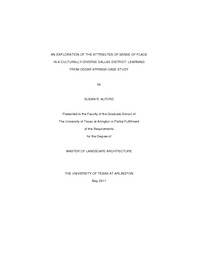| dc.description.abstract | Neighborhood centers rich in cultural diversity and history are desirable and special places for communities. Cedar Springs "The Strip" is a dynamic gay commercial neighborhood center serving Cedar Springs district's and is specified as unique although experiencing socio-spatial changes in character as expressed by its community (Vanderslice, 2008; Zillow, 2010). Even though research in literature reveals various definitions of sense of place, it is not clear what attributes make a particular place special and desirable such as Cedar Springs district which in turn can inform design and plans to respond to the community's sense of place. This research identifies and evaluates the intrinsic attributes of `sense of place' in Cedar Springs district by studying the physical framework of the district and analyzing interviews and observations to unearth its esoteric qualities. Sense of place is an intangible construct of emotional attachment to place developed through environmental experiences that connect people to their surroundings (Relph, 1976; Long, 2010; and others). The research question of this study is three-fold. First, what are the attributes of sense of place in Cedar Springs district. Second, what are the most commonly cited attributes given by the participants of Cedar Springs district. Third, what are the observable neighborhood characteristics and behaviors that confirm the set of attributes which interviewees acknowledge as meaningful.This research took its methodological references from both qualitative and quantitative paradigms following case study methods with primarily in-depth interview questions supported by passive observations (Guba et al., 1985; Marcus and Francis, 1998; Taylor et al., 1998). In-depth, person-to-person interview questions are conducted in the field to develop a detailed understanding of the users' experiences and perspectives, and the passive observations aim to obtain supporting information to evaluate here and now phenomenon of the users and the space (Guba et al. 1985). This data is then refined and evaluated for common threads of community attachment and meaning, then themes are distilled which identify the intrinsic qualities of sense of place for Cedar Springs district.Findings reveal various esoteric attributes of sense of place distilled into six themes which supply a sense of place unique to Cedar Springs district. The results of the findings reveal five of the six themes to agree with the literature reviewed for this research. One of the six themes was identified as the driving force commonly characterized as supporting sense of place for Cedar Springs district and is a new emerging theme distinct from the literature review. With further research, these findings can be used to inform design and planning strategies of communities' senses of place to support sustainable behaviors and a sense of belonging for this and other unique, culturally defined districts. | en_US |

